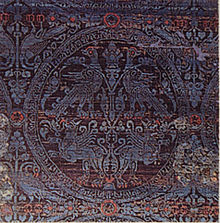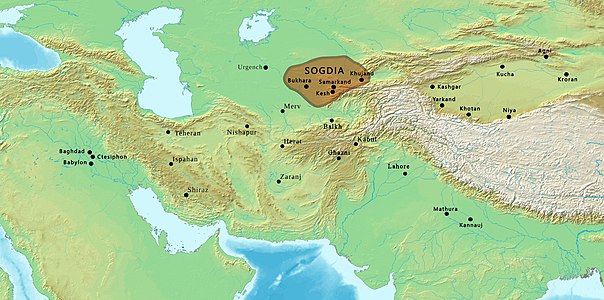Smuggling of silkworm eggs into the Roman Empire
This article or section appears to contradict itself. (November 2022) |
 The Silk Road | |
| Date | Mid-6th century (552/563 CE) |
|---|---|
| Location | Central Asia |
| Participants | Two monks |
| Outcome | Establishment of Roman silk industry |
In the mid-6th century CE, two monks, with the support of the Roman emperor Justinian I, acquired and smuggled living silkworms into the Roman Empire, which led to the establishment of an indigenous Roman silk industry that long held a silk monopoly in Europe.
Background

-
565AD. Roman Empire, blue and purple; Sassanid Empire in yellow. Sassanid vassals, in orange, encompassing theIndus river in the southeast and the Kingdom of Khotanin the northeast (both silk-growing areas).
-
Sogdiana, located in Central Asia north of the Sassanid states. Silk was also produced in the Kingdom of Khotan (east of Sogdiana) at this time, and in the Indian subcontinent, east of the Sassanid Empire
-
Silk production also occurred in these areas of East Asia in 560AD, in the Northern and Southern dynasties or Six Dynasties period
Expedition
Two unidentified monks (most likely members of the
Since adult
Impact

Shortly after the expedition there were silk factories in Constantinople, Beirut, Antioch, Tyre, and Thebes.[4] The acquired silkworms allowed the Roman Empire to have a silk monopoly in Europe. The acquisition also broke the Chinese and Persian silk monopolies.[8] The resulting monopoly was a foundation for the Roman economy for the next 650 years until its demise in 1204.[11] Silk clothes, especially those dyed in imperial purple, were almost always reserved for the elite in Byzantium, and their wearing was codified in sumptuary laws.[1] Silk production in the region around Constantinople, particularly in Thrace in northern Greece, has continued to the present (see: Silk museums of Soufli).
Sources
- ^ a b c "Silk". University of Washington. Retrieved 20 April 2013.
- ^ Norwich, John (1988), Byzantium: The Early Centuries pg. 265
- ^ a b Clare, Israel (1906), Library of Universal History: Mediaeval History pg. 1590
- ^ a b c d e Norwich, pg. 266
- ^ Walker, Alicia (2021). "Cross-cultural Artistic Interaction in the Early Byzantine Period". In Freeman, Evan (ed.). Smarthistory Guide to Byzantine Art.
- ^ a b Clare, pg. 1589
- ^ Clare, pg. 1587
- ^ a b c d Patrick Hunt. "Late Roman Silk: Smuggling and Espionage in the 6th Century CE". Stanford University. Archived from the original on 26 June 2013. Retrieved 20 April 2013.
- ^ "The Smithsonian on Silk Production". Archived from the original on September 27, 2009.
- ^ "History of Silk - The Silk Museum". Archived from the original on 1 July 2020.
- ^ Muthesius, Anna (2003), Silk in the Medieval World pg. 326



